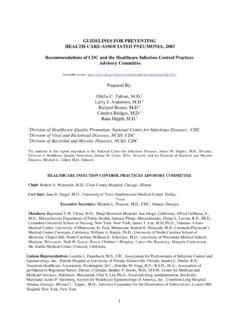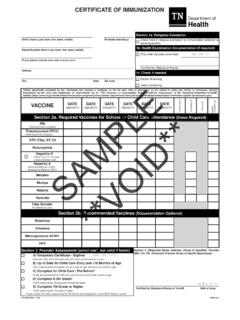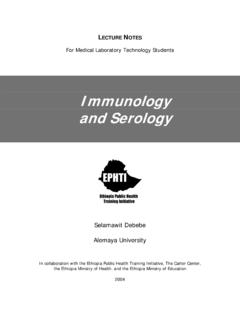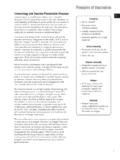Transcription of ANNEX I SUMMARY OF PRODUCT CHARACTERISTICS
1 1 ANNEX I SUMMARY OF PRODUCT CHARACTERISTICS 2 1. NAME OF THE MEDICINAL PRODUCT Nimenrix powder and solvent for solution for injection in pre-filled syringe Meningococcal groups A, C, W-135 and Y conjugate vaccine 2. QUALITATIVE AND QUANTITATIVE COMPOSITION After reconstitution, 1 dose ( ml) contains: Neisseria meningitidis group A polysaccharide1 5 micrograms Neisseria meningitidis group C polysaccharide1 5 micrograms Neisseria meningitidis group W-135 polysaccharide1 5 micrograms Neisseria meningitidis group Y polysaccharide1 5 micrograms 1conjugated to tetanus toxoid carrier protein 44 micrograms For the full list of excipients, see section 3.
2 PHARMACEUTICAL FORM Powder and solvent for solution for injection. The powder or cake is white. The solvent is clear and colourless. 4. CLINICAL PARTICULARS Therapeutic indications Nimenrix is indicated for active immunisation of individuals from the age of 6 weeks against invasive meningococcal disease caused by Neisseria meningitidis groups A, C, W-135, and Y. Posology and method of administration Posology Nimenrix should be used in accordance with available official recommendations. Primary immunisation Infants from 6 weeks to less than 6 months of age: two doses, each of ml, should be administered with an interval of 2 months between doses.
3 Infants from 6 months of age, children, adolescents and adults: a single mL dose should be administered. An additional primary dose of Nimenrix may be considered appropriate for some individuals (see section ). Booster doses Long-term antibody persistence data following vaccination with Nimenrix are available up to 10 years after vaccination (see sections and ). After completion of the primary immunisation course in infants 6 weeks to less than 12 months of age, a booster dose should be given at 12 months of age with an interval of at least 2 months after the last Nimenrix vaccination (see section ). 3 In previously vaccinated individuals 12 months of age and older, Nimenrix may be given as a booster dose if they have received primary vaccination with a conjugated or plain polysaccharide meningococcal vaccine (see sections and ).
4 Method of administration Immunisation should be carried out by intramuscular injection only. In infants, the recommended injection site is the anterolateral aspect of the thigh. In individuals from 1 year of age, the recommended injection site is the anterolateral aspect of the thigh or the deltoid muscle (see sections and ). For instructions on reconstitution of the medicinal PRODUCT before administration, see section Contraindications Hypersensitivity to the active substances or to any of the excipients listed in section Special warnings and precautions for use Traceability In order to improve the traceability of biological medicinal products, the name and the batch number of the administered PRODUCT should be clearly recorded.
5 Nimenrix should under no circumstances be administered intravascularly, intradermally or subcutaneously. It is good clinical practice to precede vaccination by a review of the medical history (especially with regard to previous vaccination and possible occurrence of undesirable effects) and a clinical examination. Appropriate medical treatment and supervision should always be readily available in case of a rare anaphylactic event following the administration of the vaccine. Intercurrent illness Vaccination with Nimenrix should be postponed in subjects suffering from an acute severe febrile illness. The presence of a minor infection, such as a cold, should not result in the deferral of vaccination.
6 Syncope Syncope (fainting) can occur following, or even before, any vaccination especially in adolescents as a psychogenic response to the needle injection. This can be accompanied by several neurological signs such as transient visual disturbance, paraesthesia and tonic-clonic limb movements during recovery. It is important that procedures are in place to avoid injury from faints. Thrombocytopenia and coagulation disorders Nimenrix should be given with caution to individuals with thrombocytopenia or any coagulation disorder since bleeding may occur following an intramuscular administration to these subjects. 4 Immunodeficiency It may be expected that in patients receiving immunosuppressive treatment or patients with immunodeficiency, an adequate immune response may not be elicited.
7 Persons with familial complement deficiencies (for example, C5 or C3 deficiencies) and persons receiving treatments that inhibit terminal complement activation (for example, eculizumab) are at increased risk for invasive disease caused by Neisseria meningitidis groups A, C, W-135 and Y, even if they develop antibodies following vaccination with Nimenrix. Protection against meningococcal disease Nimenrix will only confer protection against Neisseria meningitidis groups A, C, W-135 and Y. The vaccine will not protect against any other Neisseria meningitidis groups. A protective immune response may not be elicited in all vaccinees.
8 Effect of prior vaccination with plain polysaccharide meningococcal vaccine Subjects previously vaccinated with a plain polysaccharide meningococcal vaccine and vaccinated with Nimenrix 30 to 42 months later had lower Geometric Mean Titres (GMTs) measured with a serum bactericidal assay using rabbit complement (rSBA) than subjects who had not been vaccinated with any meningococcal vaccine in the preceding 10 years (see section ). The clinical relevance of this observation is unknown. Effect of pre-vaccination antibody to tetanus toxoid The safety and immunogenicity of Nimenrix was evaluated when it was sequentially administered or co-administered with a vaccine containing, diphtheria and tetanus toxoids , acellular pertussis, inactivated polioviruses (1, 2 and 3), hepatitis B surface antigen and Haemophilus influenzae type b polyribosyl ribose phosphate conjugated to tetanus toxoid (DTaP-HBV-IPV/Hib) in the second year of life.
9 The administration of Nimenrix one month after the DTaP-HBV-IPV/Hib vaccine resulted in lower rSBA GMTs against groups A, C and W-135 compared with co-administration (see section ). The clinical relevance of this observation is unknown. Immune response in infants aged 6 months to less than 12 months A single dose administered at 6 months was associated with lower human complement serum bactericidal assay (hSBA) titres to groups W-135 and Y compared with three doses administered at 2, 4, and 6 months (see section ). The clinical relevance of this observation is unknown. If an infant aged 6 months to less than 12 months is expected to be at particular risk of invasive meningococcal disease due to exposure to groups W-135 and/or Y, consideration may be given to administering a second primary dose of Nimenrix after an interval of 2 months.
10 Immune responses in toddlers aged 12-14 months Toddlers aged 12-14 months had similar rSBA titres to groups A, C, W-135 and Y at one month after one dose of Nimenrix or at one month after two doses of Nimenrix given two months apart. A single dose was associated with lower hSBA titres to groups W-135 and Y compared with two doses given two months apart. Similar responses to groups A and C were observed after one or two doses (see section ). The clinical relevance of this observation is unknown. If a toddler is expected to be at particular risk of invasive meningococcal disease due to exposure to groups W-135 and/or Y, consideration may be given to administering a second dose of Nimenrix after an interval of 2 months.

















